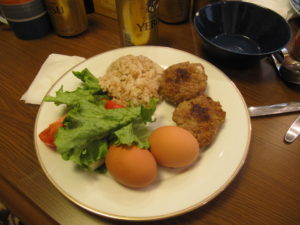
W.Minh Tuan
(Based on Healthline and other scientific sources)
There are so many super healthy foods. However, it is important to note that more is not always better.
Certain foods can be good for you in moderation, but can be seriously harmful in large amounts.
Here are 8 foods that are extremely healthy, but can be harmful to you if eaten in excess.
1-Omega 3-Oil has too much vitamin A, causing vitamin A poisoning
Omega-3 fatty acids are rich in vitamin A, which is essential for our health.
They fight inflammation in the body, play an important role in brain development and reduce the risk of heart disease.
Since most of our daily diets are low in omega-3s, it’s common to take multivitamins, or supplements, to add omega-3 fatty acids, or fish oil, for daily food.
The most popular multivitamin-supplements include omega-3 fish oil capsules that are produced from fish, fish liver, and algae.
However, too much omega-3 can be harmful.
Usual doses range from 1–6 grams per day, but taking up to 13–14 grams per day may have a blood-thinning effect in healthy people.
This can be risky, especially for people who bleed easily or are taking blood thinners.
Furthermore, taking large amounts of cod liver oil can lead to excessive absorption of vitamin A, which can cause vitamin A toxicity.
Too much vitamin A is especially harmful to children and pregnant women.
Acute vitamin A toxicity in children can result from administration of large doses (> 300,000 units [> 100,000 RAE]) which is often accidental.
In adults, acute poisoning has occurred when arctic explorers ate large amounts of polar bear liver, or seal liver, which contained several million units of vitamin A.
Chronic vitamin A toxicity in older children and adults usually occurs after doses of > 100,000 units (> 30,000 RAE)/day for many months.
Megavitamin therapy is a possible cause, as continuously administered daily doses of vitamin A (150,000 to 350,000 units [50,000 to 120,000 RAE]) or its metabolites, are sometimes administered for symptomatic disease, acne or other skin disorders.
Adults who consume > 4500 units of vitamin A (> 1500 RAE)/day may develop osteoporosis.
Infants given excessive doses of water-soluble vitamin A (18,000 to 60,000 units [6,000 to 20,000 RAE]/day) can develop toxicity within a few weeks.
Birth defects are seen in children when mothers take isotretinoin (which is related to vitamin A) to treat acne during pregnancy.
High doses of vitamin A can be toxic to the liver.
Although carotene is converted to vitamin A in the body, eating too much carotene causes carotenemia, not vitamin A poisoning. Caroteneemia is usually asymptomatic but can lead to carotenosis, in which the skin becomes Yellow.
Although the symptoms of vitamin A poisoning can vary, headache and rash often develop in acute or chronic poisoning.
Acute poisoning causes increased intracranial pressure.
Drowsiness, irritability, abdominal pain, nausea, and vomiting are common.
Sometimes the skin can peel off.
Early symptoms of chronic poisoning are sparsely distributed, coarse hair; eyebrow loss; dry, rough skin; dry eyes; and cracked lips.
Then there was severe headache, idiopathic intracranial hypertension (pseudotumor brain), and generalized weakness.
Cortical hyperplasia and arthralgia may occur, especially in children. May be prone to fractures, especially in the elderly.
In children, poisoning can cause itching, loss of appetite, and poor growth. Hepatomegaly and splenomegaly may be present.
In carotenosis, the skin (but not the sclera) becomes deeply yellow, especially on the palms and soles.
2- Tuna.
Tuna is a fatty fish that is generally considered very healthy. It is a good source of omega-3 fatty acids and is very rich in protein.
Eating too much tuna will increase the risk of vitamin A poisoning as mentioned above.
In addition, tuna can also contain high levels of an environmental pollutant called methylmercury.
At higher levels, methylmercury is a neurotoxin that can cause many adverse health effects.
These include developmental delays in children, vision problems, lack of coordination, and impaired hearing and speech.
Large tuna contains the most mercury because it builds up in their tissues over time.
These big tunas will most likely be served to you as a prime fish steak or used in sushi.
Smaller tuna contains lower amounts of mercury and is more likely to be canned.
The safe upper limit of methyl mercury for humans is 0.1 micrograms per kilogram of body weight.
This means that a 25 kg (55 lb) child can only eat one 75 g (2.6 oz) serving of canned white tuna every 19 days.
More than this will exceed the upper limit, which will cause tuna poisoning.
Pregnant women and children should limit eating seafood contain mercury no more than twice per week.
There are some other fish that are also rich in omega-3-vitamin A fatty acids but have less mercury and are therefore safer, such as salmon, mackerel, and sardines.
3-Cinnamon
Cinnamon is a delicious, widely used spice that may have a number of healing properties.
It is high in antioxidants and has been shown to have anti-inflammatory and blood sugar-lowering abilities. Eating cinnamon has also been linked to a reduced risk of heart disease, diabetes, cancer, and neurodegenerative diseases.
However, cinnamon contains large amounts of a compound called coumarin, which can be harmful if taken in large doses.
The tolerable daily amount of coumarin is 0.1 mg per kilogram of body weight.
Consuming more than that can cause liver toxicity and cancer.
Based on an acceptable daily intake, no more than 0.5–2 grams of Cassia cinnamon should be consumed per day. However, you can eat up to 5 grams (1 teaspoon) of Ceylon cinnamon per day.
It’s okay to eat more than that from time to time, like if a recipe calls for it. But large quantities should not be eaten too often.
4–nutmeg
Nutmeg is a spice with a very unique flavor. It is often used in Christmas dishes such as egg wine, cakes and puddings.
Nutmeg contains a compound called myristicin, which is a psychostimulant.
In lower doses, nutmeg brings flavor to meals without compromising health. But in large doses, nutmeg can cause myristicin poisoning.
Effects of myristicin poisoning include seizures, cardiac arrhythmias, nausea, dizziness, pain, and hallucinations.
Do not eat more than 10 grams of nutmeg in one sitting. Doses higher than those have been shown to cause symptoms of toxicity).
5-Coffee
Coffee is a great beverage packed with antioxidants and other positive compounds.
It has been linked to many health benefits, including a reduced risk of liver disease, type 2 diabetes, and neurodegenerative diseases.
The active ingredient in regular coffee is caffeine, with each cup containing an average of 80–120 mg. A daily intake of 400 mg is generally considered safe.
However, consuming more than 500–600 mg per day may be excessive.
This can overwhelm the nervous system, causing insomnia, nervousness, irritability, stomach cramps, heart palpitations, and muscle tremors.
6-Animal liver
The viscera are the most nutritious part of an animal, and the liver is the most nutritious of them all.
It is rich in essential nutrients, such as iron, B12, vitamin A and copper.
However, 100 grams of beef liver contains more than 6 times the recommended dietary intake of vitamin A (RDI) and 7 times the RDI of copper.
Vitamin A is a fat-soluble vitamin, which means it is stored in our bodies. Therefore, an excess can cause symptoms of vitamin A toxicity.
These symptoms can include vision problems, bone pain and an increased risk of fractures, nausea and vomiting.
Eating too much copper can cause copper poisoning.
This can lead to oxidative stress and neurodegenerative changes, and may increase the risk of Alzheimer’s disease.
7- Cruciferous vegetables are a family of green vegetables that includes broccoli, Brussels sprouts, kale, cabbage, and collard greens.
These vegetables have been linked to many health benefits, such as a reduced risk of cancer and heart disease.
Cruciferous vegetables make up a large part of people’s daily vegetable intake. They have also become very popular as an ingredient in many green smoothies and fresh vegetable juices.
However, compounds in these vegetables called thiocyanates can interfere with the body’s ability to absorb iodine.
This can contribute to a condition called hypothyroidism.
Hypothyroidism is characterized by an underactive thyroid gland. Symptoms include an enlarged thyroid gland, weight gain, constipation, dry skin, and decreased energy levels.
8- Brazil nuts
Brazil nuts are one of the best dietary sources of selenium.
Selenium is an essential trace element, but can be toxic in large amounts.
The recommended daily intake of selenium is 50–70 micrograms/day for adults. In addition, the higher tolerable level for safe intake is about 300 micrograms/day for adults.
One large Brazil nut can contain up to 95 micrograms of selenium. This is more than the recommended daily amount for adults and three times the amount needed for children.
Eating just 4–5 Brazil nuts can put an adult above the safe upper limit of selenium, so you shouldn’t eat more than that.
Symptoms of selenium poisoning include hair and nail loss, digestive problems, and memory difficulties).
(Based on Healthline and other scientific sources)

